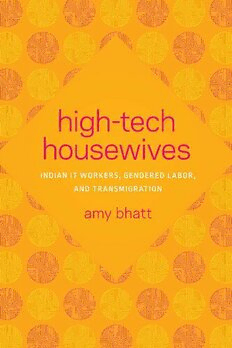
High-Tech Housewives: Indian IT Workers, Gendered Labor, and Transmigration PDF
Preview High-Tech Housewives: Indian IT Workers, Gendered Labor, and Transmigration
Padma Kaimal K. Sivaramakrishnan Anand A. Yang Series Editors High-Tech Housewives Indian IT Workers, Gendered Labor, and Transmigration Amy Bhatt University of Washington Press Seattle Copyright © 2018 by the University of Washington Press Printed and bound in the United States of America Composed in Minion Pro, typeface designed by Robert Slimbach 22 21 20 19 18 5 4 3 2 1 All rights reserved. No part of this publication may be reproduced or transmitted in any form or by any means, electronic or mechanical, including photocopy, recording, or any information storage or retrieval system, without permission in writing from the publisher. Portions of chapter 4 were published previously as Amy Bhatt, Madhavi Murty, and Priti Ramamurthy, “Hegemonic Developments: The New Indian Middle Class, Gendered Subalterns, and Diasporic Returnees in the Event of Neoliberalism,” Signs: A Journal of Women in Culture and Society 36, no. 1 (2010): 127–52, www.journals.uchicago.edu/journals/ signs; and Amy Bhatt, “Resident ‘Non-resident’ Indians: Gender, Labor and the Return to India,” in Transnational Migration to Asia: The Question of Return, ed. Michiel Baas, 55–72 (Amsterdam: Amsterdam University Press, 2015), reprinted with permission of Amsterdam University Press. University of Washington Press www.washington.edu/uwpress Library of Congress Cataloging-in-Publication Data on file isbn 978-0-295-74354-7 (Hardcover) isbn 978-0-295-74355-4 (Paperback) isbn 978-0-295-74356-1 (Ebook) To my favorites, Kevin Bromer and Anika Bromer To my eternal supporters, Ranjana and Pradip Bhatt Contents Acknowledgments ix Introduction: Gender, Transmigration, and Citizenship ............ 3 1 Transmigrants: Identity, Nationalism, and Bridge Building ........ 18 2 Engineer Brides and H-1B Grooms: Visas, Marriage, and Family Formation. . . . . . . . . . . . . . . . . . . . . . . . . . . . . . . . . . . . . . . . . 47 3 Transnational Housewives: Work Restrictions and the Gendered Division of Labor. . . . . . . . . . . . . . . . . . . . . . . . . . . . . 66 4 Returnees: “R2I,” Citizenship, and the Domestic Sphere ...........96 5 Re-migrants: Challenges, Repatriation, and Future Migrations ....................................... 124 Conclusion: Circulations ..................................... 141 Notes 149 Bibliography 177 Index 197 Acknowledgments When I first moved to Seattle in 2004, I became involved with Chaya Seattle (now API Chaya), an advocacy organization aimed at ending family-based violence and creating community among South Asian women in the region. As the tech industries in the Pacific Northwest exploded, so too did the South Asian population. In particular, the arrival of new temporary workers from India, along with women coming on family reunification visas, were a vital part of this IT boom. Some of these women came to the attention of Chaya staff as they faced isolation and sometimes violence in their home lives. Although not all H-4 holders experienced abuse, many were stuck in remote suburbs and were largely absent from the larger South Asian com- munity institutions in the area. I began volunteering on a small project aimed at reaching out to those women, which ultimately brought me into contact with some of the participants of this study. While the issue of H-4 vulnerability was still my foremost concern, I grew interested in a larger question: what role does the family play in sustaining and promoting trans- national migration and how do women fare as a result of that movement? To answer that question and others, I tapped into a rich network of Indian information technology (IT) workers, thanks to introductions from colleagues such as Tapoja Chaudhuri, Sharmistha Ghosh, and Bill Nord- wall. Through those introductions, I met nearly a hundred current and former H-1B and H-4 visa holders who were willing to share their stories and experiences with me. It is their stories that drive this study; they are the embodied subjects of transnationalism whose labor is a major force in the IT industry globally. While my focus was predominantly on the Pacific Northwest, it quickly became clear to me that their stories did not end with their arrival to the United States. Instead, their initial migration on the H-1B or H-4 visa was a stepping-stone along a circuitous journey that often included moving back and forth between India and the United States. In order to trace the consequences of these repeated migrations, I traveled to Bangalore and Hyderabad, India, to visit some of the former H-1B and H-4 visa holders I had met in Seattle and to meet others like them who had moved back after living in the United States for long stretches. Even though ix
